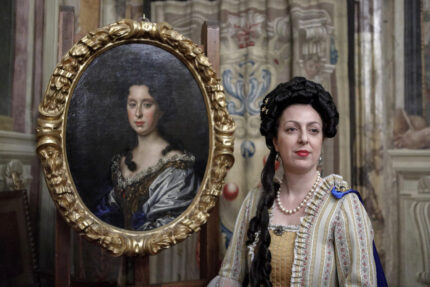
Anna Maria Luisa was the last of her dynasty, and after her death, the enormous artistic and architectural patrimony of the Medici was inherited by Francis Stephen of Lorraine, husband of Empress Maria Teresa of Austria, who would certainly have scattered it all, taking what he wanted to Vienna, melting down objects he didn’t care to keep, busting up Anna Maria’s legendary jewelry collection to sell the stones and selling off the innumerable artworks, objects and furnishings that today draw millions of tourists to Florence to the highest bidder. It is only thanks to the Family Pact she negotiated that the cultural treasures of Florence remained intact and in Florence instead of dispersed or destroyed. She died in the Pitti Palace (one of the museums offering free admission on the 18th) and her portrait welcomes visitors at the entrance to the Uffizi Gallery, an institution she created by stipulating in the Pact that it be transformed from the private family art gallery into one of the first public museums in Europe.
With her childlessness and death at the crux of Florence’s destiny, historians have hypothesized that syphilis, contracted from her philandering but much-loved husband, was the cause of both. Her body was exhumed in late 2012 as part of a collaborative project to assess damage caused to the family burials in the Medici Chapel in the Church of San Lorenzo. Osteological examination found no evidence of syphilis, to everyone’s surprise. Even Anna Maria herself was convinced she had it.
Contemporary sources, including the British diplomat Horace Mann, chronicle that in the winter of 1741, an “ugly evil began to open itself on one side of the breast, and was examined and considered by Dr. Franchi to be unhealable.” The lesion was also described as a “deep plague under the left breast, which keeps getting deeper and wider and continuously emits an acrid, biting liquid, and sometimes a small hemorrhage of blood.”
Anna Maria thought the “ugly evil” was a syphilitic ulcer and, fearful that it would expose her beloved late husband for his many sins and posthumously destroy his reputation, refused to be seen by anyone besides Dr. Franchi and her ladies in waiting. Over the next two years, her health declined steadily as she isolated herself in her rooms. Soon she was so weak she could not get out of bed. A fervently devout woman, the Electress was unable to attend mass at her private chapel even in a wheelchair.
The morning of February 18th, 1743, she “rendered her soul to God.” It was Carnivale time, and Anna Maria’s death cast a profound pall on Florence. Horace Mann wrote: “All of our happiness is finished. The Carnivale is ruined and we must cancel all of the costume parties: The Electress died an hour ago.”
Shortly before her death, she wrote instructions on the disposition of her body. She wanted only her ladies to wash her face and hands before burial. She did not want her cadaver “uncovered or opened up,” and wanted to be buried immediately. That did not happen. The Medici had a centuries-old tradition of removing organs and embalming their dead family members, and when her body was exhumed from the crypt in the Basilica of San Lorenzo 270 years later, her viscera and lungs were found in a separate vessel.
When the exhumation took place in October of 2012, the research team took extraordinary measures to grant the Electress some measure of the dignity she had sought. For the week her coffin and its contents were examined, view of the tomb was blocked by opaque plastic sheeting. The remains were 3D scanned so they could be studied virtually while her actual bones returned to their final resting place. DNA was also taken from a bone fragment and from the organs interred separately. Breast cancer now seems the most likely cause of death, but the results of the investigation have not yet been published.
* This article was originally published here








No comments:
Post a Comment